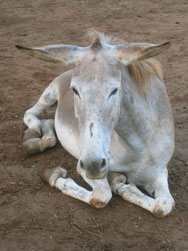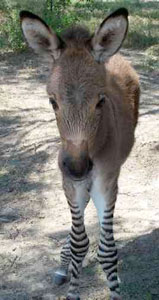- The placement of a donkey’s eyes in its’ head enables it to see all four feet at all times!
- Friendship between donkeys is precious and long. They choose their friends carefully and bond for ever. They do feel sad and down when such a dear friend is sold or dies
- Donkeys can live for over 40 years
- Donkeys were first domesticated around 4500 years ago and, at one time were a status symbol of their owners’ wealth, rather like a Rolls Royce is today
- The donkey’s characteristic ‘Eee awe’ sound is made by an intake of breadth followed instantly by exhalation
- A male donkey is called a jack.
- A female donkey is called a jennet or jenny
- Nervous horses have been known to calm down with a donkey companion as a stall or pasture mate. With horses recovering from surgery or injury or with nervous horses such as race or show horses, the donkey seems to have a calming effect
- The donkey has shown time and time again how wonderful it is with children and handicapped people. While there are a few exceptions, the donkey is not usually a biter or kicker. They have the patience of Job and therefore are ideally suited to being around children. For use around children, the handicapped a jennet or gelding is the preferred animal


- Eeyore is the famous character in the Winnie the Pooh books. He is characterized as a gloomy, old stuffed donkey and a friend of the title character Christopher Robin. He has a long tail with a pink bow on the end, of which he is very fond, but he is also prone to loose his tail. Luckily Christopher is able to reattach the tail with a black drawing pin
- Donkeys come in different colors, but gray dun is the most notable. Furthermore there are white donkeys, different shades of brown, blacks, sorrels, even a few pink donkeys. Most will have white muzzles, eye rings, and light colored bellies
- White donkeys are great for pulling charts; but don’t try the grey ones, they hate it and prefer baskets on their backs
- Donkeys have tough compact hooves that can handle sand and rock. Their woolly hair insulates from desert heat and cold. They have a digestive system that can break down almost anything that is inedible roughage.
- A working donkey, usually a jennet, sometimes a gelding (jacks rarely work because they can be too aggressive with lambs) is introduced to the herd and undergoes a bonding stage. After it has bonded with the sheep, it will protect them against canine predators (fox, coyote, dogs) as it would one of its own. This is extremely beneficial in areas where the sheep have many acres to graze. The advantage of the donkey over the guard dog is that they can eat the same food as the sheep so they don’t have to be fed separately. The donkey will also bed down with the sheep at night. Given a strange sound it will voice a warning to the flock which alerts them to danger. Then the donkey will chase and often trample the predator
- In Tanzania near the game parks one often has a couple of donkeys grazing with the cattle. The farmers say that lions will not attack such mixed herds
- Donkeys can be very jealous animals, by petting one you risk getting a kick from another one nearby especially when it is not a ‘friend’!
- The standard size donkey is also very adept at halter breaking young calves and young horses. The donkey wears a collar that is connected to the halter of the animal that is being taught to lead. The animals are then turned loose in an enclosure, always under supervision. Where the donkey wants to go, it will go. The colt or calf has no option but to follow. By allowing the donkey to perform the unpleasant task of lead training, the “trainee” doesn’t associate people with this particular stressful situation. In fact, when you release the colt or calf from the donkey, they are usually very willing to follow you
- Donkeys are very aware of their surroundings and are very cautious animals. If they think they are in danger, they will refuse to move another step, which is often mistaken as stubbornness
- Donkeys evolved in the desert, because food was scarce.
- The donkey voice, his mighty bray, is used to keep in contact with other donkeys and to mark their territories. Their large funnel ears can catch the distant calls and helps dissipate some of the hot desert heat
- The miniature donkey originates from the Mediterranean islands of Sicily and Sardinia. The adult male miniature donkey is no more than 90 cm tall when mature, about as high as your kitchen counter


- Donkeys can be used like horses under saddle and in harness, although donkeys have a more self-preserving nature. They prefer to do what is good for the donkey, which is not always what the human thinks is best, especially when it comes to getting their feet wet
- Donkeys are known to be one of the most intelligent and friendliest known animals, but should not be left by its self. They need companionship
- A lone donkey is a lonely donkey
- Most donkeys seem to really detest small dogs. HOWEVER, many many people who have donkeys also have dogs. If breeders raise newborn donkeys around dogs, there’s a chance that they can get along nicely.
- Mothers with foals can never be trusted around dogs even if they got along with them before they had their foal, simply because new mothers are so protective
- It is said, “It takes a good sense of humor to be owned by a set of long ears”… and …“ If you have purchased a donkey once and love it, another will follow” because they are like potato chips, you can’t just have one!
- When a male zebra and a female donkey mate the offspring is called a ‘zedonk’ or ‘zebrass’.
- The resulting offspring are sterile, i.e. they cannot produce offspring themselves.
- Donkey’s milk was once valued as a medicine and was given to premature babies and sick children and to people suffering from tuberculosis. Donkey’s milk contains more sugar and protein than cow’s milk and less fat.
- In Southern Spain there is a ‘giant’ pure breed of donkey called the ‘Andalucian-Cordobesan’, which can reach up to 16 hands high, that’s as big as a racehorse! Unfortunately this donkey species is in danger of extinction; a survey in 2000 by the University of Cordobain estimated that there are probably as few as 150 Andalucians left.
“A tail isn’t a tail to them, it’s just a little bit extra at the back”
Eeyore
Winnie the Pooh
